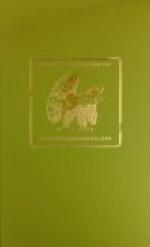They had reached the entrance to the Morganstein box; the orchestra was playing again, the curtain began to rise on the second act, and Daniels hurried back to his place. But during the next intermission, an usher brought the young reporter a note. It was written concisely on a business card, but Jimmie read it through slowly a second time before he handed it to the Society Editor.
“Mrs. Feversham wants to see that story,” so it ran. “Leave it at my office in the morning. She may take it east with her. Knows some magazine people who are going to feature Alaska and the Northwest.”
After a thoughtful moment Miss Atkins returned the card to Jimmie. “Is it the Indian story?” she asked.
Daniels nodded, watching her face. His smouldering excitement was ready to flame. “They will read it for Mrs. Feversham,”—Geraldine’s voice trembled slightly—“and they will take it. It’s a magazine story. They ought to pay you handsomely. It’s the best thing you ever wrote.”
Marcia Feversham saw possibilities in that story. Indeed, writing Jimmie from Washington, she called it a little masterpiece. There was no doubt it would be accepted somewhere, though he must expect to see it cut down considerably, it was so long. Then, presumably to facilitate the placing of the manuscript, she herself went over it with exceeding care, revising with her pencil, eliminating whole paragraphs, and finally fixing the end short of several pages. In the copy which her husband’s stenographer prepared, the original was reduced fully a third. After that it mellowed for an interval in Marcia’s drawer.
At the close of November, it was announced that Stuart Foster, the junior defendant in the first “Conspiracy to defraud the Government” trial, was weather-bound in Alaska. This, taken in consideration with the serious illness of Tisdale, on whom the prosecution relied for technical testimony, resulted in setting the case for hearing the last week in the following March. It was at this time, while Hollis was lying unconscious and in delirium at a hospital, that his great wealth began to be exploited. Everywhere, when inquiries were made as to his health, fabulous statements followed about the Aurora. To mention the mine was like saying “Open Sesame!” Then, finally, it was whispered and repeated with conviction by people who “wouldn’t have believed it of Hollis Tisdale” at the beginning, that he had defrauded the widow of his dead partner—who had made the discovery and paid for it with his life—of her share.
Then, at last, early in December, Jimmie’s masterpiece was forwarded to a new magazine in New York.
“Dear Mr. Sampson;—” so Marcia wrote—
“Here is a story of Western life that I believe will be of interest to you. The incident actually occurred. The man who killed the Indian child, and who amused my brother’s guests with the story while we were cruising lately on the Aquila, was Hollis Tisdale of the Geographical Survey. He is probably the best known figure in Alaska, the owner of the fabulously rich Aurora mine. His partner, who made the discovery, paid for it with his life, and there is a rumor that his wife, who should have a half interest, is penniless.




